Hello Tomorrow Global Summit is an annual event – hosted in Paris – bringing together deep tech startups, investors and ecosystem supporters. The conference always provides a great opportunity to meet like-minded members of the deep tech community and learn more about the cutting-edge technologies being built today.
The mood this year was positive, perhaps not surprising given that deep tech is now the biggest sector of VC in Europe, although much debate ensued on how to provide an environment for long-term growth before Europe can consider itself comparable with the US.
Here are five of the most prominent technology areas being discussed and some interesting startups we met within each category.
Data centre tech
There were a number of companies tackling the demand for higher bandwidth and more energy-efficient optical interconnect for data centres: innovative modulation schemes (Phanofi), all-optical transceiver chips (NEW Photonics) and novel end-end optical networking (Astrape Networks).
Novel compute
Whilst there were a handful of companies within the quantum compute space, there were surprisingly few tackling novel compute. Two of note were Literal Labs (formerly Mignon) with their Tsetlin machine approach to AI, and Nanomation, a spinout from Cambridge that has developed novel software for utilising nanomaterials in next-gen chipmaking, neuromorphic computing, quantum applications and biosensing.
Outside of hardware, Embedl are an interesting Swedish startup utilising neural search, pruning and other mechanisms to reduce ML model size for more efficient deployment (and performance) on edge processors.
AR/VR/XR
The AR/VR/XR space remains a target for startups and spinouts from academic research, despite the lacklustre performance of the smartglasses sector to-date (albeit with renewed interested following the launch of Apple’s Vision Pro).
Propositions ranged from Holographic Extended Reality (HXR) projection chips (Swave Photonics) for spatial computing, through ultra-bright laser-based displays enabling better use of smartglasses in sunny conditions (VitreaLab), to SPAE sensors for energy-efficient 3D scene scanning and eye/gaze tracking (VoxelSensors).
Sensing
Sensing in general was a surprisingly well-attended space with a number of deep tech startups covering a wide gamut of industrial and consumer applications.
Multispectral imaging has emerged over the past few years covering a broad range of applications based on the wavelengths supported, and the size and cost of the imaging system.
In many cases, the focus is on industrial applications and replacing (or at least complementing) existing sensing systems (LiDAR, radar, cameras) to improve performance in adverse weather conditions or harsh environments (such as mining), or for use on production lines for spotting anomalies and defects.
Spectricity is unique in this regard by targeting consumer applications in smartphones (e.g., skin health, improved colour photography etc.) as well as industrial applications in agritech and manufacturing.
Elsewhere in sensing, simple RGB camera systems are getting a boost through AI (Tripleye), and companies such as Calyo are demonstrating an ability to deliver ultra-low SWAP-C 3D imaging through novel use of Ultrasound.
3D digital twins
And finally, startups such as Blackshark.AI and AVES Reality are using satellite and other imaging data for generating hyper-realistic 3D representations of the physical world for use across a range of applications including training for autonomous vehicles, digital representations & planning for utility companies, and a number of dual use civil/military applications.
Executive summary
AI has exploded onto the scene, capturing the imagination of the public and investment community alike, and with many seeing it as transformative in driving future economic growth. Certainly, it’s finding its way into all manner of devices and services.
But its thirst for data and generative capabilities across all modalities (text, images, audio, video etc.) will drive a need for a more hyperconnected compute fabric encompassing sensing, connectivity, processing and flexible storage. Addressing these needs will likely be dependent on a paradigm shift away from just connecting things, to enabling “connected intelligence”. Future networks will need to get ‘smarter’, and will likely only achieve this by embracing AI throughout.
Emergence of AI
Whilst AI has been around for 70 years, recent advances in compute combined with the invention of the Transformer ML architecture and an abundance of Internet-generated data has enabled AI performance to advance rapidly; the launch of ChatGPT in particular capturing worldwide public interest in November 2022 and heralding AI’s breakout year in 2023.
Many now regard AI as facilitating the next technological leap forward, and it has been recognised as a crucial technology within the UK Science & Technology Framework.
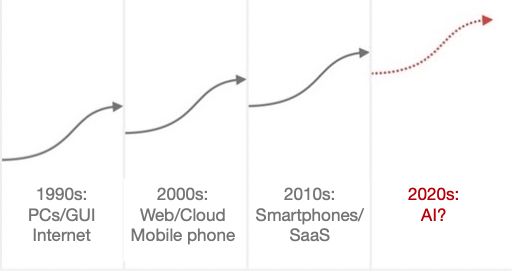
But how transformative will AI really be?
Sundar Pichai, CEO Alphabet believes “AI will have a more profound impact on humanity than fire, electricity and the internet”, whilst Bill Gates sees it as “the most important advance in technology since the graphical user interface”.
Investor sentiment has also been very positive, AI being the only sector within Deep Tech to increase over the past year, spurred on by the emergence of Generative AI (GenAI).
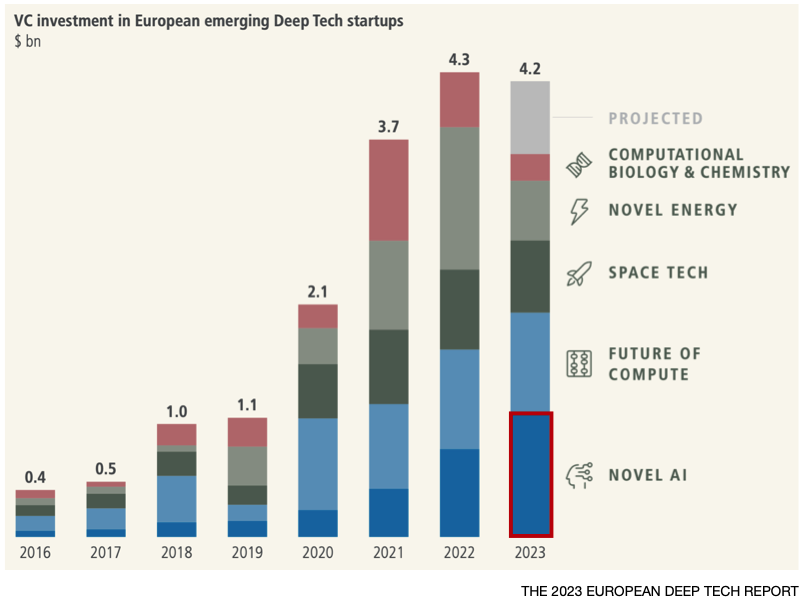
But is GenAI just another bubble?
The autonomous vehicle sector was in a similar position back in 2021, attracting huge investment at the time but ultimately failing to deliver on expectations.
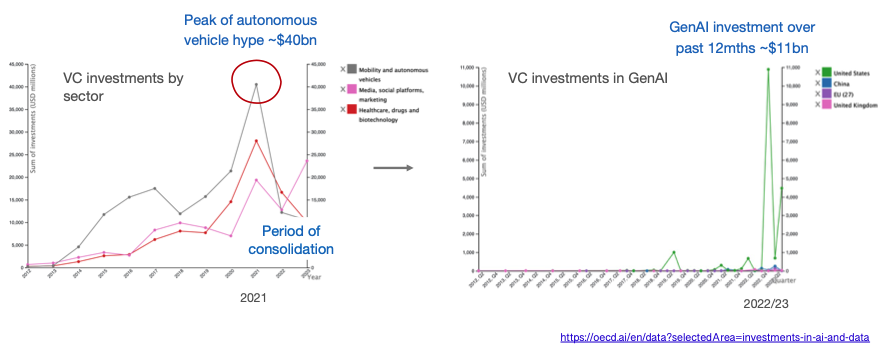
In comparison, commercialisation of GenAI has gotten off to an impressive start with OpenAI surpassing $2bn of annualised revenue and potentially reaching $5 billion+ this year, despite dropping its prices massively as performance improved – GPT3 by 40x; GPT3.5 by 10x with another price reduction recently announced, the third in a year.
On the back of this stellar performance, OpenAI is raising new funding at a $100bn valuation ~62x its forward revenues.
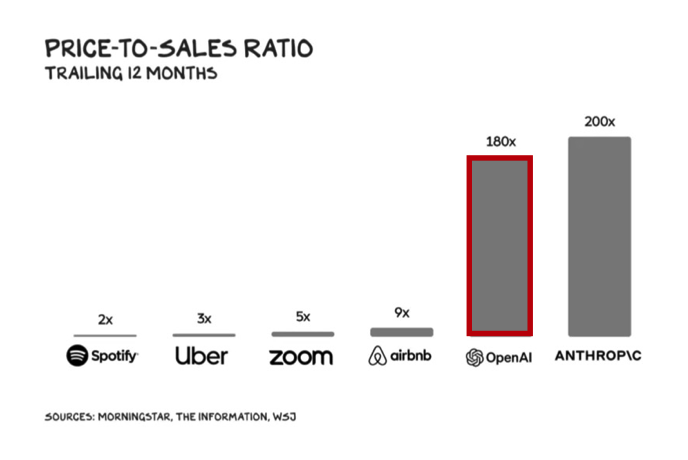
Looking more broadly, the AI industry is forecast to reach $2tn in value by 2030, and contribute more than $15 trillion to the global economy, fuelled to a large extent by the rise of GenAI.

Whilst undeniably value creating, there is concern around AI’s future impact on jobs with the IMF predicting that 40% may be affected, and even higher in advanced economies. Whether this results in substantial job losses remains a point of debate, the European Central Bank concluding that in the face of ongoing development and adoption, “most of AI’s impact on employment and wages – and therefore on growth and equality – has yet to be seen”.
Future services enabled/enhanced by AI
Knowledge workers
GenAI has already shown an impressive ability to create new content (text, pictures, code) thereby automating, augmenting, and accelerating the activities of ‘knowledge workers’.
These capabilities will be applied more widely to the Enterprise in 2024, as discussed in Microsoft’s Future of Work report, and also extend to full multimodality (text, images, video, audio etc.), stimulating an uptick in more spatial and immersive experiences.
Spatial & immersive experiences (XR)
The market for AR/VR headsets has been in decline but likely to get a boost this year with the launch of Meta’s Quest 3 and Apple’s Vision Pro ‘spatial computer’.
Such headsets, combined with AI, enable a range of applications including:
- Enabling teams to collaborate virtually on product development
- Providing information for engineers in the field – e.g., Siemens and Sony
- Simulating realistic scenarios for training purposes (such as healthcare)
- Showcasing products (retail) and enabling new entertainment & gaming experiences
The Metaverse admittedly was over-hyped, but enabling users to “see the world differently” through MR/AR or “see a different world” through VR is expected to boost the global economy by $1.5tn.
Cyber-physical & autonomous systems
Just as AI can help bridge the gap for humans between the physical and the digital, GenAI can also be used to create digital twins for monitoring, simulating and potentially controlling complex physical systems such as machinery.
AI will also be used extensively in robotics and other autonomous systems, enhancing the computer vision and positioning & navigation (SLAM) of smart robots in factories, warehouses, ports, and smart homes with predictions that 80% of humans will engage with them daily by 2030.
Personal devices
And finally, AI is already prevalent in many personal devices; in future, “Language models running on your personal device will become your very personal AI assistant”.
Connected Intelligence
These future services will drive a shift to more data being generated at the edge within end-user devices or in the local networks they interface to.
As the volume and velocity increases, relaying all this data via the cloud for processing becomes inefficient, costly and reduces AI’s effectiveness. Moving AI processing at or near the source of data makes more sense, and brings a number of advantages over cloud-based processing:
- improved responsiveness – vital in smart factories or autonomous vehicles where fast reaction time is mission critical
- increased data autonomy – by retaining data locally thereby complying with data residency laws and mitigating many privacy and security concerns
- minimising data-transfer costs of moving data in/out of the cloud
- performing continuous learning & model adaptation in-situ
Moving AI processing completely into the end-user device may seem ideal, but presents a number of challenges given the high levels of compute and memory required, especially when utilising LLMs to offer personal assistants in-situ.
Running AI on end-user devices may therefore not always be practical, or even desirable if the aim is to maximise battery life or support more user-friendly designs, hence AI workloads may need to be offloaded to the best source of compute, or perhaps distributed across several, such as a wearable offloading AI processing to an interconnected smartphone, or a smartphone leveraging compute at the network edge (MEC).

Future networks, enabled by AI
Future networks will need to evolve to support these new compute and connectivity paradigms and the diverse requirements of all the AI-enabled services outlined.
5G Advanced will meet some of the connectivity needs in the near-term, such as low latency performance, precise timing, and simultaneous multi-bearer connectivity. But going forward, telecoms networks will need to become ‘smarter’ as part of a more hyperconnected compute fabric encompassing sensing, connectivity, processing and flexible storage.

Natively supporting AI within the network will be essential to achieving this ‘smartness’, and is also the stated aim for 6G. A few examples:
Hardware design
AI/ML is already used to enhance 5G Advanced baseband processing, but for 6G could potentially design the entire physical layer.
Network planning & configuration
Network planning & configuration is increasing in complexity as networks become more dense and heterogeneous with the move to mmWave, small cells, and deployment of neutral host and private networks. AI can speed up the planning process, and potentially enable administration via natural language prompts (Optimisation by Prompting (OPRO); Google DeepMind).
Network management & optimisation
Network management is similarly challenging given the increasing network density and diversity of application requirements, so will need to evolve from existing rule-based methods to an intent-based approach using AI to analyse traffic data, foresee needs, and manage network infrastructure accordingly with minimal manual intervention.
Net AI, for example, use specialised AI engines to analyse network traffic accurately in realtime, enabling early anomaly detection and efficient control of active radio resources with an ability to optimise energy consumption without compromising customer experience.
AI-driven network analysis can also be used as a more cost-effective alternative to drive-testing, or for asset inspection to predict system failures, spot vulnerabilities, and address them via root cause analysis and resolution.
In future, a cognitive network may achieve a higher level of automation where the human network operator is relieved from network management and configuration tasks altogether.
Network security
With the attack surface potentially increasing massively to 10 million devices/km2 in 6G driven by IoT deployments, AI will be key to effective monitoring of the network for anomalous and suspicious behaviour. It can also perform source code analysis to unearth vulnerabilities prior to release, and thereby help mitigate against supply chain attacks such as experienced by SolarWinds in 2020.
Energy efficiency
Energy consumption can be as high as 40% of a network‘s OPEX, and contribute significantly to an MNO’s overall carbon footprint. With the mobile industry committing to reducing carbon emissions by 2030 in alignment with UN SDG 9, AI-based optimisation in conjunction with renewables is seen as instrumental to achieving this.
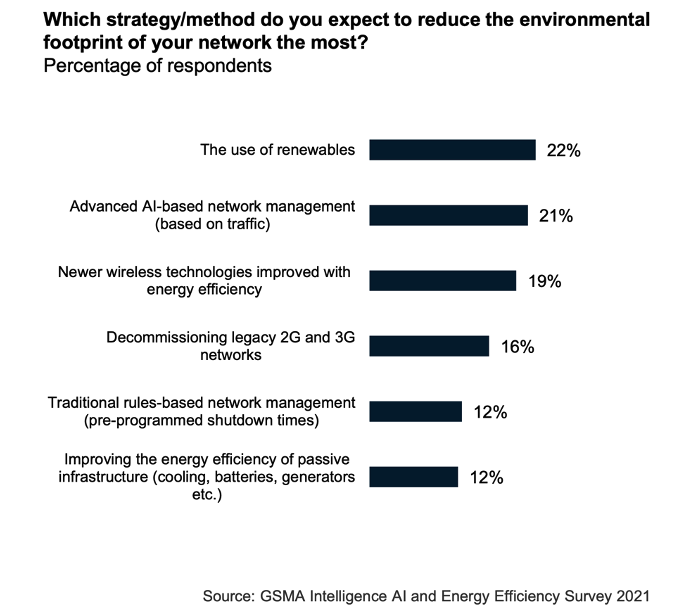
Basestations are the ‘low-hanging fruit’, accounting for 70-80% of total network energy consumption. Through network analysis, AI is able predict future demand and thereby identify where and when parts of the RAN can be temporarily shut down, maintaining the bare-minimum network coverage and reducing energy consumption in the process by 25% without adversely impacting on perceived network performance.
Turkcell, for example, determined that AI was able to reduce network energy consumption by ~63GWh – to put that into context, it’s equivalent to the energy required to train OpenAI’s GPT-4.
Challenges
Applying AI to the operations of the network is not without its challenges.
Insufficient data is one of the biggest constraints, often because passive infrastructure such as diesel generators, rectifiers and AC, and even some network equipment, are not IP-connected to allow access to system logs and external control. Alternatively, there may not be enough data to model all eventualities, or some of the data may remain too privacy sensitive even when anonymised – synthesising data using AI to fill these gaps is one potential solution.
Deploying the AI/ML models themselves also throws up a number of considerations.
Many AI systems are developed and deployed in isolation and hence may inadvertently work against one another; moving to multi-vendor AI-native networks within 6G may compound this issue.
The AI will also need to be explainable, opening up the AI/ML models’ black-box behaviour to make it more intelligible to humans. The Auric framework that AT&T use for automatically configuring basestations is based on decision trees that provide a good trade-off between accuracy and interpretability. Explainability will also be important in uncovering adversarial attacks, either on the model itself, or in attempts to pollute the data to gain some kind of commercial advantage.
Skillset is another issue. Whilst AI skills are transferable into the telecoms industry, system performance will be dependent on deep telco domain knowledge. Many MNOs are experimenting in-house, but it’s likely that AI will only realise its true potential through greater collaboration between the Telco and AI industries; a GSMA project bringing together the Alan Turing Institute and Telenor to improve Telenor’s energy efficiency being a good example.
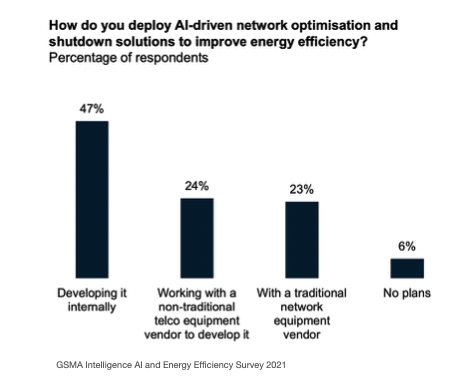
Perhaps the biggest risk is that the ecosystem fails to become sufficiently open to accommodate 3rd party innovation. A shift to Open RAN principles combined with 6G standardisation, if truly AI-native, may ultimately address this issue and democratise access. Certainly there are a number of projects sponsored within the European Smart Networks and Services Joint Undertaking (SNS JU) such as ORIGAMI that have this open ecosystem goal in mind.
Takeaways
The global economy today is fuelled by knowledge and information, the digital ICT sector growing six times faster than the rest of the economy in the UK – AI will act as a further accelerant.
Achieving its full potential will be dependent on a paradigm shift away from just connecting things, to enabling “connected intelligence”. Future networks will need to get ‘smarter’, and will likely only achieve this by embracing AI throughout.
The UK is a leader in AI investment within Europe; but can it harness this competence to successfully deliver the networks of tomorrow?

Foreword from David Leftley (CTO)
Light and its compositions has fascinated scientists for more than 2,000 years – from Aristotle to Newton, Young, Hertz and Maxwell et.al. But it was ultimately Einstein, with his photoelectric effect theory, who postulated that light is made up of particles called photons. Einstein is famous for his research on the theory of relativity yet it was his work on theoretically revealing the photoelectric effect based on the light quantum hypothesis that won him the Nobel Prize in physics in 1921.
The photon has many mysterious physical properties such as possessing the dual properties of a wave and a particle. And it was Einstein himself who described things such as entanglement as “spooky”. Learning more about these properties is allowing us to use light more effectively than ever before and applying this knowledge allows us to make significant advances in many new areas of science and technology. To date, photonics has been predominantly applied to communications with the introduction of optical fibre transforming networks as early as the 1960’s. But now we are seeing photonics taking hold in other areas such as computing, AI, sensing and quantum communications.
In the following brief, David Pollington explores the challenges and exposes some of the early stage innovation opportunities that exist in Photonics and these application areas.
The introduction of PICs
Until now, photonics has focused predominantly on enabling high-speed communications, a lucrative market that now tops $10bn just for optical transceivers. But photonics also has application in many other areas ranging from solid-state LiDAR to inertial navigation sensors, spectrometers, refractive index biosensors, quantum computers, and accelerating AI.
This article discusses the merits of using photons rather than electrons with an especial focus on photonic integrated circuits (PICs), the wide range of integrated photonics use cases, the current industry landscape of PICs, and the opportunities for startups to innovate in this space.
A PIC is a microchip containing photonic components which form a circuit that processes photons as opposed to electrons to perform a function.
In comparison with digital microelectronic circuits in which the majority of functions are performed using transistors, with photonics it’s a little more complex; there’s no single dominant device but rather a variety of components which can be either passive (e.g. couplers, switches, modulators, multiplexers) or active (e.g., amplifiers, detectors, lasers) and then interconnected via waveguides to form a circuit.
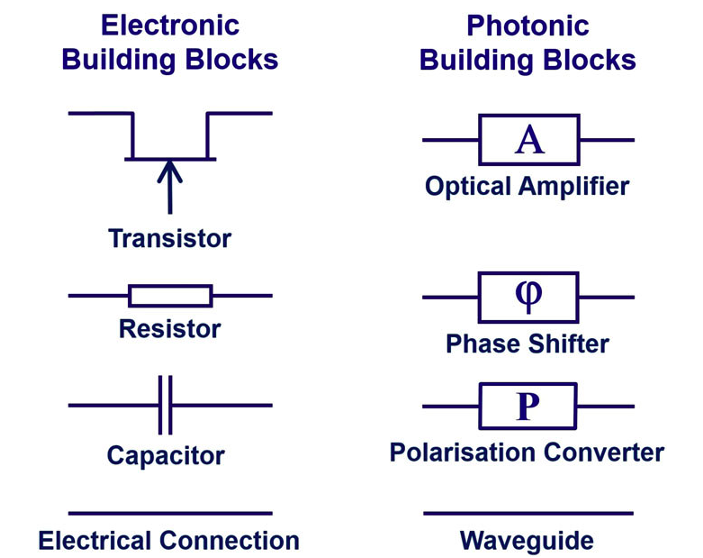
Figure 1: Electronic and photonic circuit building blocks [AIP Publishing]
Similar to digital microelectronics, photonic circuits can be fabricated on silicon, enabling high-density PICs to be made in existing CMOS foundries and co-integrated with transistor-based electronics. Silicon on insulator (SOI) has been the most widely used process within silicon photonics (SiPh) but is likely to be replaced in certain applications by Silicon Nitride (SiN) due to its wider spectral range, low propagation loss and higher power handling (particularly useful for detectors, spectrometers, biosensors, and quantum computers).
However, neither of the silicon-based processes can generate light on their own nor allow for the integration of active components, hence a separate process, Indium Phosphide (InP), is commonly used for fabricating high-performance amplifiers, lasers, and detectors.
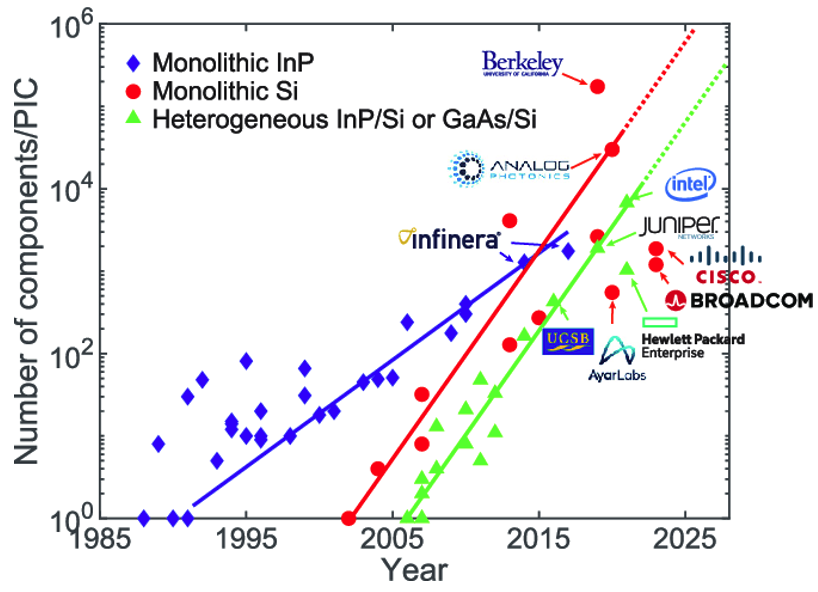
Figure 2: Number of photonic components/PIC [Chao Xiang, University of California]
The design challenges with PICs
Photonic circuit design is complex; individual components need to be tailored to the target application requirements (wavelengths; linearities; power levels), process types (SiPh, InP, SiN) and fabs (characterisation), and hence often need to be designed from scratch, requiring large design teams and/or a dependency on independent design houses.
Once the photonic circuit has been designed and verified there are still hurdles in packaging, laser integration, testing and additional processing steps – whilst packaging, assembly, and testing are only a small part of the cost for digital microelectronics (10%), the reverse is true for photonics, and can be as much as 80% of the total cost for InP photonic devices.
Fabs are starting to address this issue by providing process design kits (PDKs) that designers can use to design, simulate, and verify designs before handing them back to the foundry for fabrication. These PDKs include a base set of photonic building blocks (BBs) to bootstrap the design process but are often limited to particular wavelengths and applications (e.g., telecoms).
A market opportunity therefore exists for design houses and other 3rd parties to license out BBs and even entire circuits that fit the broader set of application requirements. LioniX, for example, offers a range of SiN PIC modules, whilst PhotonDelta, a growth accelerator for the Dutch integrated photonics industry, offers a number of design libraries.
EDA tools can then be used for combining these BBs into photonic circuits whilst facilitating seamless integration of electronic and photonic components in IC designs where needed.
However, as mentioned earlier, these designs still then need to be optimised/characterised for the target process/fab, as imperfections and fluctuations of even a few nanometres can cause scattering or reflections and affect performance. In many respects, the photonic circuit design process is more akin to RF and PCB design than digital microelectronics – mostly analogue, and needing careful selection and qualification of components.
A number of parties are exploring ways of addressing some of these issues and accelerating photonic design. Researchers in Canada, for instance, are using machine learning to predict the precise structure of a photonic component once it’s fabricated to a particular process/fab thereby enabling accurate simulation and optimisation to circumvent the ‘trial and error’ nature of photonic design. Similarly, a startup in the UK, Wave Photonics, has pioneered computational techniques to auto-adapt functional building blocks for different wavelengths, fabs and performance design trade-offs.
Nevertheless, the fabrication process still involves a degree of trial and error today, and it may well be 3-5yrs and require a large number of wafer runs and assemblies before the process is perfected sufficiently to deliver the predictable outcomes required to scale up to larger circuits and high volumes.
The use of photonics in communications & networking
Digital microelectronics has become pervasive, but with the demand for ever-faster compute and higher-bandwidth networking, the interaction of electrons with other particles in the copper wires at these speeds is resulting in higher energy consumption, more heat, and restrictions to performance. Photons don’t suffer from any of these constraints being virtually frictionless and able to travel faster, support higher bandwidths, and be more energy efficient, hence present an intriguing alternative.
Whilst optical links have been introduced within data centres to form high-speed clusters, the wiring within the racks is typically copper, and as processing demands continue to rise, this is creating a bottleneck and issues around both energy consumption and cooling.
The answer is likely to be through Co-Packaged Optics (CPO) in which the switch ASICs and optical engines are integrated on a single packaged substrate to move the optical connection as close as possible to the switching chip. Doing so enables higher density integration and improves cost effectiveness and energy efficiency with savings of up to 30% of the total system power. Ayar Labs, for example, integrate the optical/electrical components of a transceiver bar the laser inside an optical I/O chiplet.
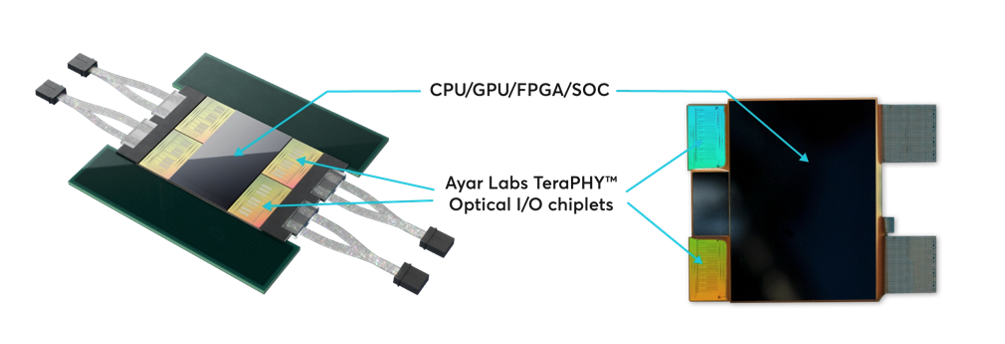
Figure 3: Ayar Labs optical I/O chiplet [Ayar Labs]
In a similar vein, Nvidia and TSMC are interconnecting multiple AI GPUs via a chip-on-wafer-on-substrate (CoWoS) 2.5D package, and Lightmatter’s Passage enables chiplets to be interconnected via nanophotonic waveguides.
The demand for low-power optical transceivers within data centres, and in particular for Co-Packaged Optics (CPO), will be a key driver in the growth of the silicon photonics market over the next 3-5yrs ($3-4 billion by 2025).
Accelerating AI
With AI compute requirements doubling every 3.4mths (c.f. Moore’s Law which had a 2-year doubling period) [OpenAI] fuelled most recently by the race to generative AI, there is a growing need to develop novel computing systems capable of fast and energy-efficient computation.
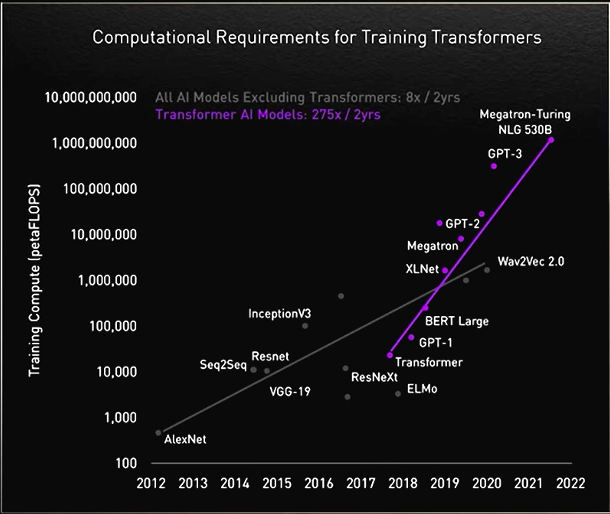
Figure 4: Computational requirements for training transformer models [Nvidia]
Silicon photonics may provide an answer, utilising the unique properties of light to solve complex mathematical problems and meet today’s AI compute demands but with energy consumption as low as one photon per operation and performed at the speed of light hence orders of magnitude faster and more energy efficient than digital computation (although getting data efficiently in/out the photonic chip remains a challenge).
To give an example, detecting edges in an image is of great use in the world of computer vision (e.g., for feature extraction or pattern detection) but requires a lot of compute to perform the CNN multiplication operations.

Figure 5: Example of image edge detection [Brighton Nkomo]
Fourier Transforms (FFT) represent a faster method, enabling the image data to be converted from the spatial domain to the frequency domain where edges will be represented by high frequencies which can be captured via a high pass filter. An inverse FFT then transforms the data back into an image showing just the edges of objects in the original image.
The downside is that FFTs themselves are computationally intensive, so this approach presents only a marginal improvement when using digital computation.
Light though has unique properties, and its interference behaviour can be used to perform FFT operations in a massively parallel way that is not only incredibly fast, but also tremendously energy efficient compared to digital computation.
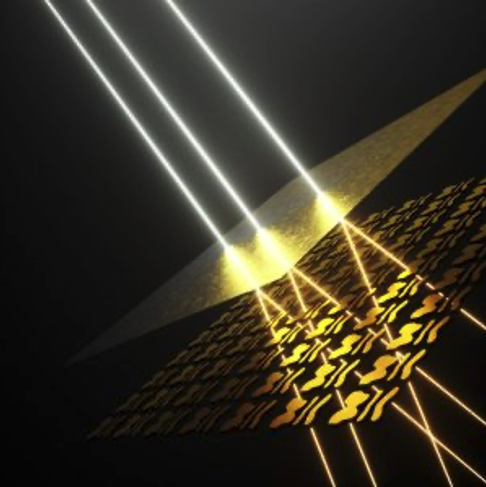
Figure 6: Solving a complex mathematic equation with light [Ella Maru studio]
In practise though, there remain a few obstacles.
Optical components can’t be packed nearly as tightly as transistors hence chip size can be an issue, although membrane-based nanophotonic technologies should in future enable tens of thousands of components per chip, and new approaches such as the use of very thin nanostructured surfaces combined with semi-transparent mirrors are being explored for performing the matrix multiplications in AI/ML inference.
Another issue is around accuracy. Today’s implementations are mainly targeted at performing inference on ML models trained using digital systems. Physical imperfections in the PIC fabrication, and quantisation noise introduced through the optical/electrical converters for getting data in and out of the photonic chip, can result in a ‘reality gap’ between the trained model and inference output that adversely affects accuracy and energy efficiency.
These challenges though present huge opportunity for innovation, whether that be through improving PIC density, optimising the optical/electrical interface to improve precision, or harnessing the unique properties of light to deliver a step-change in AI inference performance and energy efficiency.
Salience Labs for instance are pioneering a novel ‘on-memory compute’ architecture and using different wavelengths of light to facilitate highly parallelised operation and boost performance, whilst Lumai are exploring the application of photonics for more efficient ML model training.
With the AI chip market projected to be worth a colossal $309bn by 2030 [Verified Market Research], the application of integrated photonics to AI acceleration is likely to attract a lot more investor interest and innovation going forward.
Integrated photonics in sensors
At a component level, integrated photonics is being employed in inertial sensors to achieve ultra-precise positioning/indoor navigation [Zero Point Motion], and separately is enabling laser diodes to be integrated with micro-optics and electrical interfaces on a millimetre-sized chip for use in AR/VR glasses as demonstrated in this YouTube video.
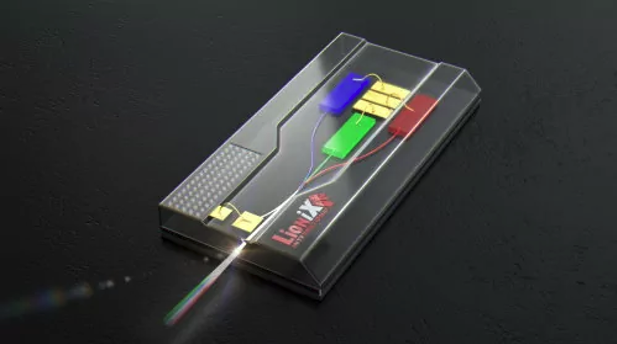
Figure 7: Fully integrated RGB laser light engine for retinal projection in AR [LionIX]
Integrated photonics also opens up the prospect of lab-on-a-chip (LOC) biosensors through a combination of miniaturisation, extreme sensitivity, supporting multiple simultaneous tests, and enabling mass production at low cost. The Point of Care (PoC) market is expected to double in the next few years to $10.1B by 2025 [Yole Development].
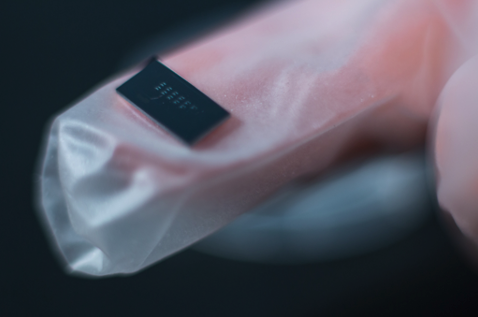
Figure 8: Diagnostics platform providing Point of Care (POC) tests [SurfiX Diagnostics]
And finally, the intrinsic benefits in photonics for computing FFTs can also be used to provide the massive vector transforms needed for fast and efficient fully homomorphic encryption (FHE) to enable secure processing in the cloud or by 3rd parties without the data ever being in the clear.
Can integrated photonics reach scale?
The opportunity is clear. But for integrated photonics to thrive and reach million-scale volumes across multiple sectors there will need to be a more comprehensive set of pre-validated design libraries and tools that decouple design from the underlying fabrication and packaging technology to enable a fabless model that attracts new entrants and innovation.
The opportunity for startups is therefore twofold 1) innovating within the design process & toolchain to reduce lead times and improve performance, 2) applying integrated photonics within new products & services in networking, AI acceleration, ultra-sensitive sensors, and healthcare.
Europe has a heritage in photonics, so it’s perhaps not surprising that European research organisations, spinouts and startups are leading the industry.
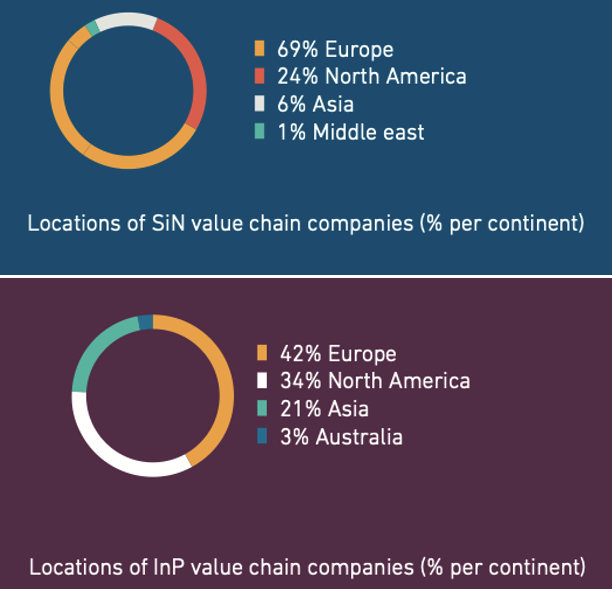
Figure 9: Value chain companies by geography [PhotonDelta: SiN; InP]
In the photonics design, packaging and testing space, example European companies include Alcyon Photonics, Wave Photonics, Bright Photonics, VLC Photonics, Photon Design, FiconTEC, PhotonDelta and LioniX.
Companies developing photonic chips to accelerate AI include Optalysys, Salience Labs and Lumai whilst those using photonics to produce ultra-sensitive sensors include Zero Point Motion, Miraex and PhotonFirst; SMART Photonics and EFFECT Photonics are addressing the telecoms/networking space, and organisations such as PhotonDelta and JePPIX are helping to coordinate the growth of integrated photonics across Europe.
Integrated photonics faces many challenges, but there is increasing evidence that the technology is set to follow the same trajectory as microelectronics over the coming years. The potential upside is therefore huge, both in terms of market value but also in the opportunity this presents for innovative startups.
If you’re a startup in this space, we’d love to hear from you.
We’re delighted to welcome Vien Phan to the team, who joins Bloc as Chief Operating Officer, as we scale our operations to support fundraising and investment activity.
Vien has nearly 20 years’ experience in finance, strategy and operations roles and is a former Group Head of Strategy for London Stock Exchange Group plc. (“LSEG”). He spent 10 years at LSEG working in Corporate Strategy and Development covering strategic planning, sourcing and screening investment and acquisition opportunities, M&A execution and integrations.
Since leaving LSEG, Vien has spent five years in a variety of advisory and operating roles serving investment firms and technology startups in the FinTech and Life Sciences sectors, with experience in early-stage company fundraising, accounting and operational finance, corporate finance, investment advisory and due diligence.
Vien started his career as a Chartered Accountant with PwC London gaining valuable transaction services and capital markets advisory experience. He holds a Masters in Molecular and Cellular Biochemistry from the University of Oxford. Having served in operating, strategic and advisory roles in both public and private high growth company environments, he brings the ideal and complementary skillset to the Bloc team.
As COO, Vien will work across Bloc’s finance and operations, embedding scalability throughout the company and its portfolio. He commented: “I’m delighted to join Bloc Ventures. It is an investment firm with a differentiated operating model, uniquely deploying patient capital into the early-stage European deep tech digital infrastructure space. The investment team has an impressive track record, a specialist understanding of the sector and provides extensive industry network and operational expertise to the portfolio. Bloc has exciting plans for the future and I’m thrilled to be part of it.”
Bruce Beckloff, CEO at Bloc Ventures, commented: “Vien’s experience over the last 20 years complements the Bloc team incredibly well. He takes our collective operational, financial and strategic expertise to another level and this will be crucial to executing Bloc’s plans for the future. We’re so pleased to have him on board.”
‘A Chat with Bruce Beckloff, CEO at Early-Stage DeepTech Investor: Bloc Ventures’. Bruce is featured in TechRound this week, sharing some of the key focus areas of Bloc and how we support deep tech companies as they take products to market. It was first published on techround.co.uk
The full article can be found here.
Pharrowtech expands into the UK and grows its management team to boost next generation wireless products. Global millimeter-wave wireless tech leader accelerates hiring and opens two new offices as it grows its product and development capabilities.
Pharrowtech, a growing market leader in mmWave solutions for next-generation wireless applications, has opened its first UK design centre in the Thames Valley area. The UK office will be led by Dr Mehul (Micky) Mehta, and it will help bolster the company’s resources and talent pool as it grows its product offering. The news comes as Pharrowtech continues to hire at pace, including the recent acquisition of two significant new management hires.
In addition to Dr Mehta’s appointment in the UK, Claudia Bastian joins as Global HR Manager based in Leuven, Belgium. Pharrowtech’s Leuven office has moved to Philipssite to accommodate the company’s growing team and operations. It boasts a new state-of-the-art mmWave laboratory with the latest equipment, including the most advanced mmWave network analyzer technology, several anechoic chambers, and chip characterization and qualification setups.
The opening of Pharrowtech’s UK office and the move to a new headquarter office in Belgium quadruples the company’s office and lab capabilities. It is an essential component in Pharrowtech’s growth, as it continues to develop complete solutions for next generation wireless applications and expands its capabilities to serve even more commercial markets. The UK office is now actively seeking engineers with skills in digital modem design, real-time embedded software and digital silicon.
Dr Mehul Mehta, Vice President of Pharrowtech UK, has more than two decades’ experience of working in technical and leadership roles in the wireless communications industry, having most recently served as CEO of Celestia Technologies Group. He is an expert in physical and MAC layer topics – with specialities in areas including radio (wireless) communications and digital design. To date, he has developed several solutions for 3GPP (UMTS, LTE), IEEE 802.11 (WLAN) and IEEE 802.16 (WiMAX) standards, has authored numerous journal and conference papers and holds 10 patents.
Claudia Bastian, Global HR Manager, Pharrowtech, brings over 30 years of international experience at global technology businesses including DellEMC and OneSpan. She will spearhead Pharrowtech’s international recruitment drive, working to attract and retain the right technical talent.
Wim Van Thillo, CEO and co-founder, Pharrowtech comments, “The last two years have been a period of rapid progress for us, with product launches, significant investments, and successful trials with leading companies in the wireless industry. We are now focused on building our world-class global team of experts to fulfil our ambitions and deliver innovative technology that meets the needs of next generation wireless applications. With its well-established history in wireless systems and silicon design, the UK is an ideal location for the next phase in our growth.”
Dr Mehul Mehta comments, “This is an exciting time for the wireless industry and Pharrowtech stood out to me as a company truly at the forefront of it. Pharrowtech’s team of experts has the potential to make some of the most advanced wireless solutions a reality, to benefit people everywhere. I’m delighted to be joining the company and to help lead this next period of expansion.”
Claudia Bastian adds, “Pharrowtech is a true pioneer in the wireless communications industry and creating a talented team with the best technical expertise will be crucial to our success. I’m looking forward to the challenge of identifying these individuals worldwide to accelerate the company’s growth.”
Those interested in receiving more information about open roles or applying, should visit: https://pharrowtech.com/careers
YellowDog appoints ARM and computing veteran Noel Hurley as CEO.
YellowDog, which transforms how businesses access compute, welcomes Noel Hurley as its new CEO. The previous CEO, Simon Ponsford, becomes CTO (a position he previously held for five years) and will focus on technology roadmap, as YellowDog grows partnerships with hyperscalers and customers.
Noel joins YellowDog after many years as an executive at Arm, the microprocessor company. During his time there he held a number of VP and General Manager positions including the business segments team responsible for initiating Arm’s entry into the cloud market as well as running the CPU division and product teams. Noel also initiated and ran Arm’s internal incubation activity working closely with start-ups across a broad range of the deep tech markets. He was also a Co-founder of Bristol based fabless semiconductor company XMOS.
Noel commented: “I am very excited to join the YellowDog team. We want to make YellowDog the window into the world’s compute allowing businesses to better manage their compute investment. I see the YellowDog platform being the core tool for businesses to right size and manage their compute resources. It has the ability to provision and schedule workloads across on-prem clusters, public and private cloud at a scale and speed not seen before. This allows customers to be agile to the needs of the market whilst keeping costs under tight control.”
Simon was part of the YellowDog founding team and spent five years as CTO before taking the reins as CEO in 2020, driving both the commercial and technology roadmap of the business since then. He will now focus on the company’s technological innovation and building solutions to support compute management for customers. Noel’s arrival will enable the team to scale.
Simon commented: “We are excited to have Noel join YellowDog. The company has over the last year managed to prove its technology and demonstrate alongside our cloud partners the ability to create compute clusters at HPC scale. Noel will bring his commercial and strategic strengths to our business as we look to further scale the YellowDog business.”
YellowDog addresses the growing cloud and compute management market that is set to grow to $1.6bn (five-year CAGR 75%) by 2027. Using its cloud native compute workload management platform, the company can provision and schedule tasks on private or public cloud alongside existing on-premise infrastructure. To date, the Platform has been used by companies innovating in Life Sciences, Financial Services and Media and Entertainment.
YellowDog is unique in being able to provision over multiple geographies simultaneously and at speeds and scales that have not been achieved before. In July 2021 working alongside AWS YellowDog built a cluster of more than 3m vCPUs in less than an hour. This helped to make YellowDog one of only 16 companies that have achieved ‘HPC competency’ certification with AWS. This month at the ISC High Performance 2022 event in Hamburg YellowDog will be making further announcements in the field of confidential compute with our OEM and Cloud partners.
Pharrowtech raises €15 million Series A to develop world’s first viable wireless alternative.
Pharrowtech, a leader in the design and development of millimetre wave (mmWave) hardware and software for next-generation wireless applications, today announces its €15 million Series A funding round to continue developing next-generation 60 GHz wireless technology.
The round was led by Innovation Industries, with participation from Bloc Ventures, imec.xpand and KBC Focus Fund. This will enable Pharrowtech to accelerate deployment of its recently launched 60 GHz CMOS Radio-Frequency Integrated Circuit (RFIC) PTR1060, and phased array antenna Radio-Frequency Module (RFM) PTM1060 for 5G unlicensed fixed wireless access, wireless infrastructure, and consumer applications. The capital will be used to ensure best in class customer support, expanding Pharrowtech’s operations in the United States, and growing its engineering and business teams to drive the product roadmap and fuel further growth.
Pharrowtech delivers a unique solution, offering gigabit-per-second speeds to consumers and businesses wirelessly. The 60 GHz frequency range is becoming increasingly important for applications such as remote working and learning, augmented and virtual reality, and entertainment and gaming, thanks to its greater capacity and lower latency. Increasingly, network operators are looking at outdoor Fixed Wireless Access (FWA) solutions as the most effective and economical solution to deliver the required gigabit-per-second speeds link to consumers. In parallel, due to the increasing capabilities of 5G radio base stations, mobile operators are deploying millimetre wave solutions to meet the increasing demand of backhaul network architectures for macro and high-density small cell deployments.
Wim Van Thillo, CEO and co-founder, Pharrowtech, says: “This year has started on a great note for Pharrowtech, and this investment is another significant milestone in our journey. Despite the challenges brought by a global pandemic, Pharrowtech was able to move rapidly from imec R&D Prototypes in 2019 to scaling up production of an exceptionally advanced 60 GHz RF solution by 2022. Our agility and capabilities have kept us ahead of the curve, delivering solutions that will shape the future of ubiquitous connectivity. We would like to thank our team, our investors, partners, and especially our customers for their faith in us. With the next phase of our growth underway, we are committed to providing RF solutions to multi-GHz links to enable low-cost infrastructure and consumer applications.”
David Leftley, CTO at Bloc Ventures, added: “60 GHz licence free spectrum is rapidly becoming the spectrum of choice where low latency and multi gigabit speeds are a requirement for infrastructure and CE wireless connectivity applications. Until now, cost and power consumption has been prohibitive to wide adoption. Pharrowtech is at the forefront of enabling this market, launching highly advanced low cost and low power CMOS RF semiconductor products. Core to the team’s latest innovation is leveraging bulk CMOS rather than more expensive and exotic fabrication processes such a SiGe. To do this is an outstanding achievement. The funding round is a testament to their expertise, execution and commitment, and we are delighted to be involved in this growth journey alongside them.”
Building on imec’s R&D and prototypes, Pharrowtech recently announced the availability of the PTR1060, the world’s first IEEE 802.11ay-compliant CMOS RF chip for indoor and outdoor wireless use cases that supports the full 57 to 71 GHz bandwidth. The company also launched PTM1060 (RFM) phased array antenna modules to provide OEM/ODMs with a ready-to-use 60 GHz solution. The integration levels, performance, and capabilities of Pharrowtech’s latest RFIC open the full potential of low-cost, small form factor and low-power FWA deployments, 5G and WiFi infrastructure backhauling, next-generation consumer electronics products, and IoT devices requiring high-speed links. The programming interfaces and tuneable features of the chip and antenna allow for optimal integration by equipment makers.
Both products are currently available to select customers and are already being designed-in by a tier-one US equipment vendor. The company is also providing demonstrations and evaluation kits to the consumers and will ramp up the production in Q3 2022.
We’re so excited to welcome Dr Alisa Molotova to the Bloc Ventures investment team. She is based in Cambridge and will help us discover new deep tech entrepreneurs looking for a specialist investor with Arm and computing as a core part of its DNA.
Alisa has been working in deep science and technology since studying genetics at University of Glasgow (placement as an engineer at GSK) and then completing her PhD (sponsored by Wellcome Trust) in Stem Cell Neuroscience at University of Cambridge, researching at the intersection of biology and physics.
Whilst studying, Alisa became Head of Commercial Strategy at a deep tech startup named Labstep, where she led their business development strategy on their mission to simplify and accelerate scientific discovery. Following her time at Labstep, Alisa moved into the investment world, looking for early-stage technology companies to back on behalf of the investment arm of the University of Cambridge (Cambridge Enterprise).
She focused primarily on Pre-seed and Seed stage investment opportunities, working on all stages of the investment process (including technical due diligence, legal negotiation and board governance), whilst building a strong network in the Cambridge ecosystem. She also organised and judged startup competitions, represented the University in raising a new social innovation fund and mentored underrepresented venture capital candidates to create a fairer and more diverse industry, through Diversity VC.
Alisa then joined Marshall Aerospace and Defence and their newly established in-house accelerator called Marshall Futureworx as a Business Development Executive. As part of the senior management team, she worked on strategic innovation projects and took the lead in developing business cases for investment into emerging technologies across space, air, land and sea for both civilian and military applications. Primarily she focused on unmanned aerial vehicles (UAV), sustainable aviation and energy management.
With experience in business building, world-leading academia, early-stage investing and corporate development, Alisa possesses skills and experience that are core the Bloc DNA and fundamental to the way we operate. Her role at Bloc will be to work alongside our research team to find deep tech investment opportunities and help us grow the Bloc portfolio as we scale.
Alisa commented: “It’s an exciting time for deep tech investing and an equally exciting time to be joining Bloc Ventures on their growth journey. I have always enjoyed working with technologists who are not content with the status quo, and I have found this determination to create change in the Bloc team and the entrepreneurs we back. I’m very excited to get started and start meeting some deep tech companies!”
Outside of her career, Alisa is a registered beekeeper, a keen photographer, long distance runner and speaks four languages. You can meet Alisa and the rest of the Bloc team on 19th May in Cambridge where we’ll be hosting an event titled ‘From PoC to IPO: the journey of a deep tech company’. Sign up here.
Join us on Thursday 19th May at The Bradfield Centre, Cambridge, from 6-9pm.
Description:
This event is designed to provide deep tech founders with the opportunity to gain a better understanding of the journey ahead and meet investors or other entrepreneurs that might be able to support them on the way. Brought to you by Bloc Ventures, Silicon Valley Bank and The Bradfield Centre.
Agenda:
– 6pm: Arrival and refreshments
– 6.30pm: Welcome from Bruce Beckloff, CEO at Bloc Ventures
– 6.40pm: Getting to Series A stage (Chaired by Dr Alisa Molotova)
Panellists: Miles Kirby (Deeptech Labs); Dr Elaine Loukes (Cambridge Enterprise); Rick Hao (Speedinvest); Dr Lee Thornton (IP Group)
– 7.20pm: Getting to Growth stage and beyond (Chaired by Michael Dimelow)
Panellists: Dr Manjari Chandran-Ramesh (Amadeus Capital); Simon King (Octopus Ventures); David Delfassy (Ahren Innovation Capital); Sonya Iovieno (Silicon Valley Bank); Pete Hutton (Cambridge Angels)
– 8pm: Refreshments and networking
– 9pm: Ends
About:
Bloc Ventures is a deep tech investor with a team made up of technologists with experience building globally successful companies like ARM and Vodafone. Typically we invest at Seed to Series A stage in companies across Europe and Israel, focused on cloud, connectivity, data science and security. Our portfolio includes companies in AI, quantum computing and IoT security. Companies can pitch directly to the Bloc investment team.
Silicon Valley Bank. The Bank of Innovation Economy. Our mission is to increase the probability of our clients’ success, by helping innovators, enterprises, and their investors move bold ideas forward fast. We provide a full range of financial services to companies of all sizes in innovation centres around the world. Learn more about Silicon Valley Bank.
